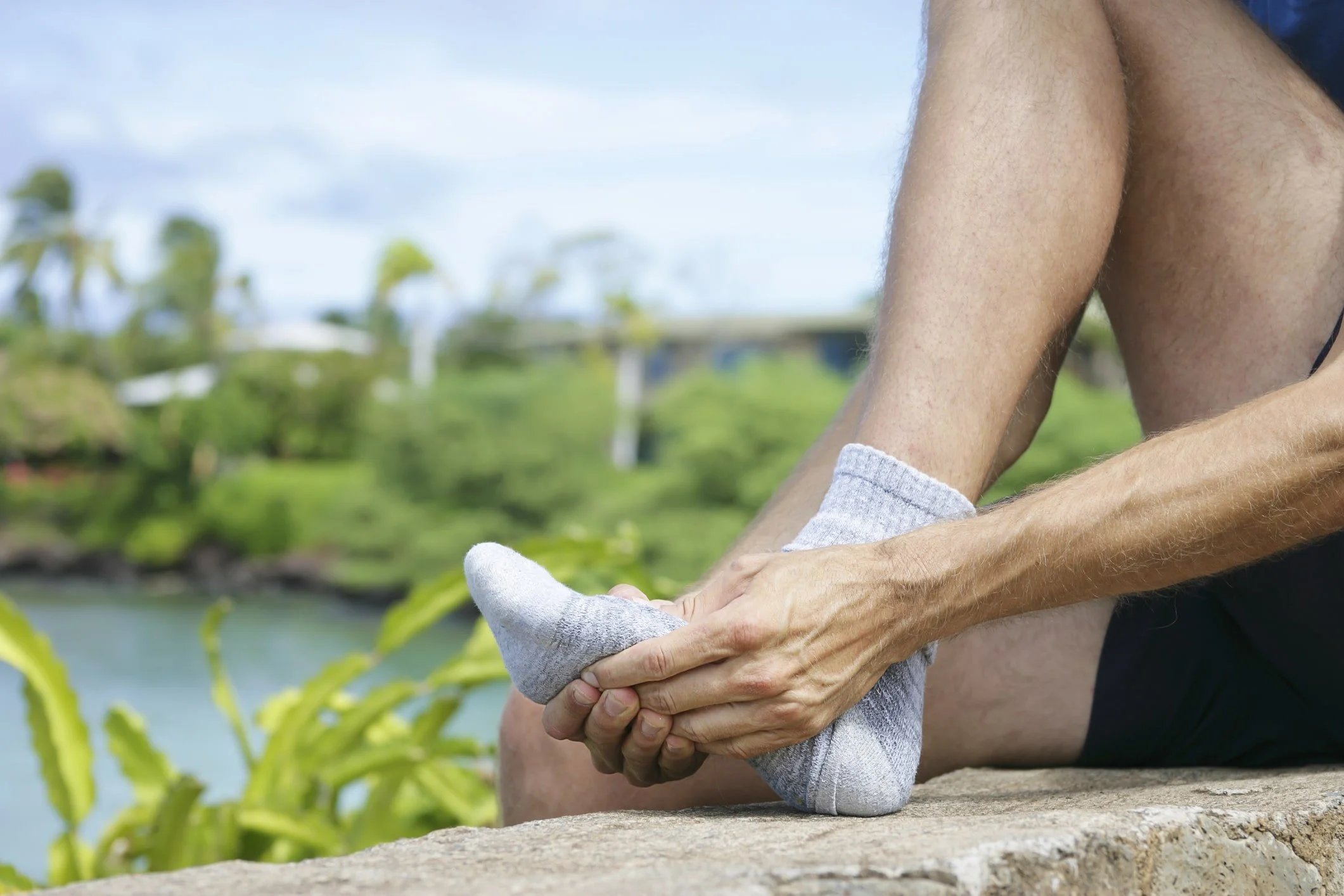10 OF THE MOST COMMON PAINFUL FOOT CONDITIONS AND INJURIES EXPLAINED
According to the American Podiatric Medical Association, 75-77% of Americans have experienced foot pain at some point in their lives. It’s not surprising considering that each foot has 26 bones, 33 joints, and over 100 muscles, tendons, and ligaments, that the average person walks around 7500 steps per day, and when running up to 4 times your body weight can be the pressure amount placed on your feet. Put all of that together and it’s no wonder that feet are prone to injury and are at high risk for developing a wide variety of painful conditions.
We’ve listed the most common foot pain diagnoses seen and treated by our team of sports medicine podiatry experts in our office (in no particular order), all of which should be evaluated by a medical professional.
PLANTAR FASCIITIS
Plantar Fasciitis is a painful inflammation of thick fibrous tissue in the foot called the plantar fascia. Pain from plantar fasciitis is usually centered under the heel and is often found to be worse at the beginning of the day. If plantar fasciitis worsens or goes untreated, it can lead to some conditions that will cause more discomfort including degeneration of the plantar fascia, called plantar fasciitis as well as many painful conditions of the heel.
TENDONITIS
Tendonitis is a common cause of pain in the foot or ankle, typically resulting from inflammation around a tendon. This condition often arises from overuse injuries, but improper stretching before physical activity or poor form during exercise can also contribute to tendonitis. Tendon injuries can be either acute, occurring suddenly, or chronic, developing gradually over time. The pain associated with tendonitis is usually dull and aching, but as the condition worsens, it may also become sharp, burning, or radiating around the foot or ankle. Other symptoms of tendonitis may include stiffness, swelling, weakness, and tenderness.
Flatfoot
Flatfoot is a common deformity that occurs in both children and adults. Although there are various forms of flatfoot, they all share one characteristic - the partial or total collapse of the arch. Flatfoot can be apparent at birth or may not show up until years later. Most children with flatfoot have no symptoms, but some may have one or several symptoms. Some symptoms are pain, tenderness, or cramping in the foot, leg, or knee. Another symptom is outward tilting of the heel resulting in awkwardness or a change in a child’s walking. Children with flatfoot may have a decreased interest in or withdrawal from physical activities.
SPRAINS AND STRAINS
Sprains and strains are different types of injuries. A sprain happens when ligaments—the bands of tissue connecting two bones—stretch or tear. A strain occurs when a muscle or tendon, which connects muscles to bones, gets damaged. Ankle sprains are the most common type of sprain. Foot sprains typically affect the middle of the foot or the big toe.
HEEL SPURS
A heel spur is a calcium deposit under the heel that causes bone protrusions. Pain from heel spurs is often confused with plantar fasciitis, which is inflammation of the plantar fascia ligament. In contrast, a heel spur is a growth directly on the heel bone. Heel spurs typically do not cause symptoms, but they can be linked to intermittent or chronic pain. This discomfort usually arises from inflammation or irritation of the plantar fascia ligament, rather than the heel spur itself. Pain often worsens in the morning upon waking and tends to improve as the ligaments loosen throughout the day.
STRESS FRACTURES
Stress fractures are tiny cracks in bones, often found in the lower body, particularly in the feet, which bear body weight during activities like walking and running. These injuries usually result from repetitive stress and are common in athletes, especially runners. Over time, continuous strain on weight-bearing bones leads to small cracks. Initially, stress fractures may not cause pain, but discomfort can develop with continued activity. Other factors may also contribute to their onset.
OSTEOARTHRITIS
Osteoarthritis is often called "wear and tear" arthritis or degenerative joint disease. With OA, the cartilage in a joint starts to break down, and the underlying bone begins to change. These changes usually happen slowly and get worse over time. Arthritis is a complex condition characterized by pain, swelling, and stiffness. Symptoms often develop gradually, starting in the smaller joints such as those in the hands and fingers, feet, and toes before progressing to larger weight-bearing joints such as the ankles, knees, hip, lower back, pelvis, and spine. It can also affect other areas such as the wrists, elbows, shoulders, neck, and jaw.
BUNIONS
A bunion—also called Hallux Valgus—is a bump that appears inside the foot, around the metatarsophalangeal (MTP) joint (near the big toe). This bump is a bone that protrudes towards the inside of the big toe. If bunions are left untreated, they can cause severe pain, hinder walking abilities, and cause an imbalance that can lead to a whole host of other issues. Bunions are a result of the weight of your body falling unevenly on the joints and tendons in your feet. This is usually caused by wearing shoes that do not fit properly or genetic deformities.
HAMMERTOES
Hammertoe is a foot deformity where the toes bend or curl downward instead of pointing forward, often due to a muscle imbalance between the tendons. It most commonly affects the second or third toe and can be flexible or rigid. Women are more likely to develop hammertoe, often due to inappropriate footwear. The condition can worsen over time, so it's important to seek medical treatment early. Ignoring hammertoe can lead to serious complications, especially for individuals with diabetes, and may affect walking ability.
MORTON’S NEUROMA
Morton's neuroma is a common condition causing pain in the ball of the foot, typically between the third and fourth toes, often feeling like a small rock in your shoe. It involves a thickening of the tissue surrounding the nerves, not a tumor. Improper footwear—like shoes that squeeze the toes or distribute weight unevenly—is a major cause. Relief can often be found by changing shoes, resting, or massaging the area. Other factors include trauma, biomechanical deformities, repeated stress, and overuse.
Foot pain comes in many shapes and forms, and has many different causes, symptoms, and factors, we’ve listed just a few of them above. These injuries and conditions can worsen, and create a multitude of secondary issues that affect the lower body extremities if ignored and left untreated. Don’t wait. Seek treatment.
If you or someone that you care for suffers from pain in the feet, ankles, knees, hips, and/or lower back, the pain may be due to misalignment caused by faulty biomechanics which can be treated and corrected with the help of custom orthotic insoles. To schedule your comprehensive biomechanical evaluation, use our contact form or call our Sports Medicine Podiatry Center and book an appointment at our Cherry Hill, N.J. Sports Medicine Facility or Ridley Park, P.A. Office location with one of our podiatric sports medicine specialists today by calling (610) 522-9200.




